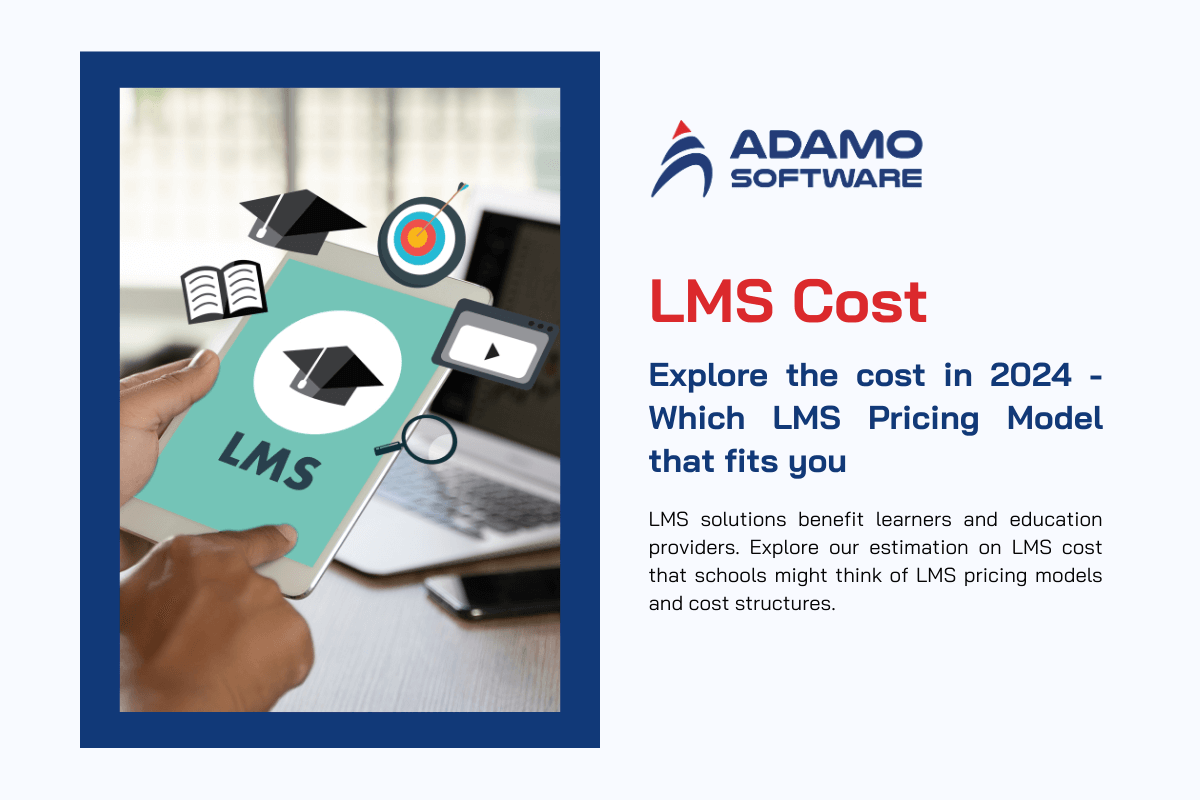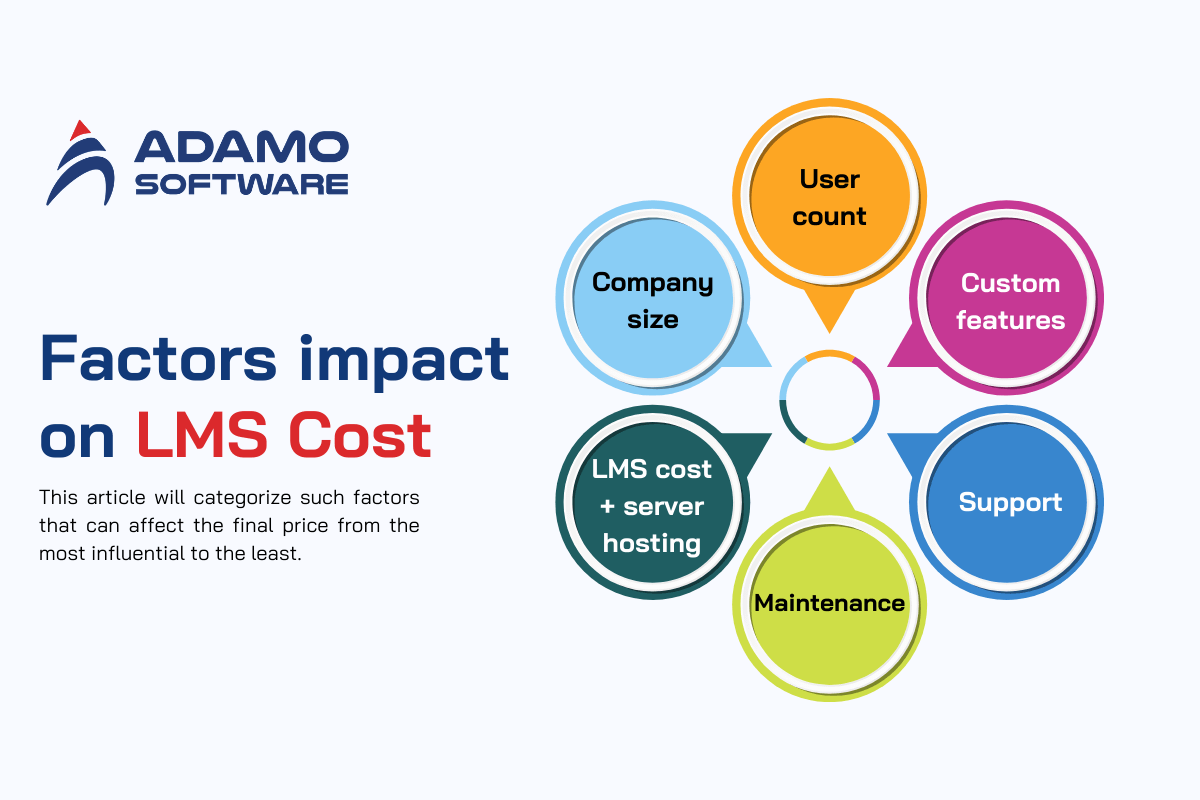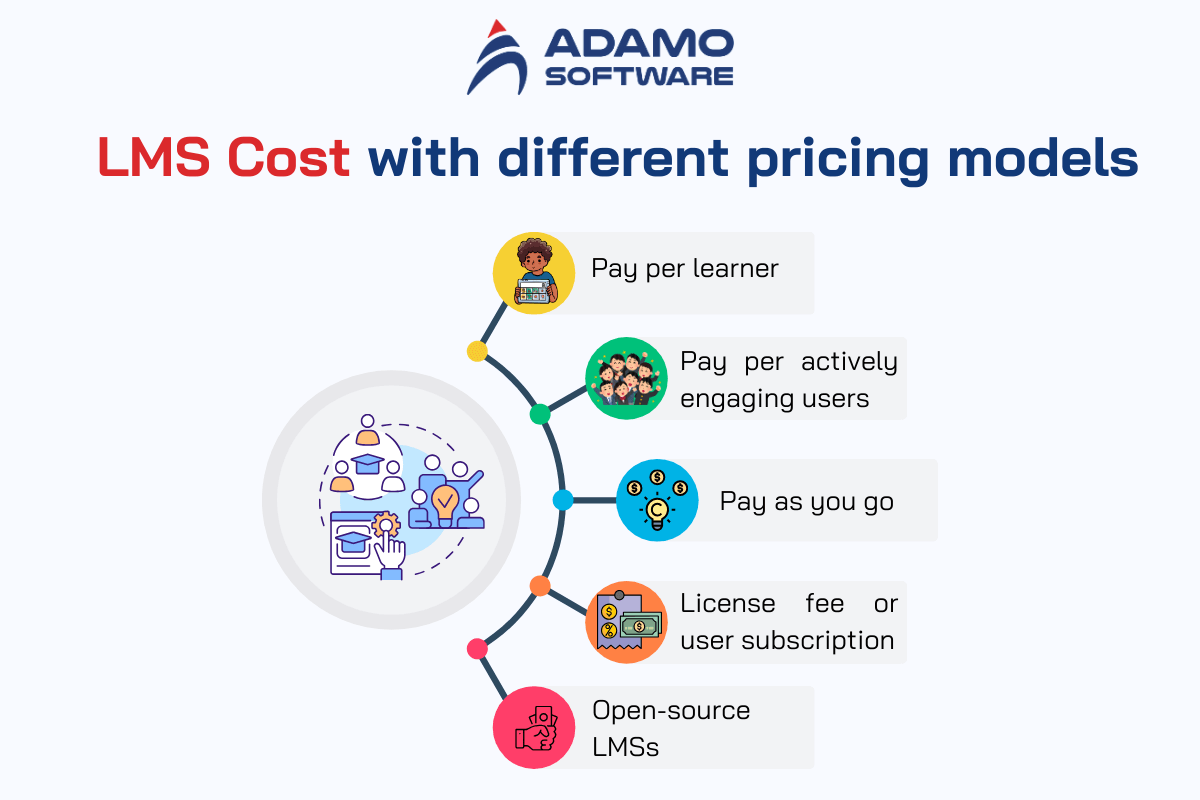Explore LMS Cost in 2024 – Which LMS Pricing Model that Fits You

LMS solutions benefit learners and education providers. Explore our estimation on LMS cost that schools might think of LMS pricing models and cost structures.
There is no doubt that a learning management system (LMS) is an effective tool that increases positive economic returns. About 98% of US-based learning and development organizations use such LMS solutions in 2023.
But LMS pricing models can be varied, which gets confused for schools and other training institutions if they don’t understand some points. They can be what factors that impact on LMS cost or how it fits your possible budgets. When choosing which LMS cost models are suitable match for you, capturing characteristics of LMS cost might help you make the right decision. Trying the right learning and training solution that fits specific needs, along with company goals requires thorough research and decision-making process. As an education development expert, Adamo is here to help you.
I. Break down of LMS pricing structures
The question of what is the LMS cost or LMS pricing structure? It is not easy to answer this question. In fact, the cost for LMS software is hard to fix and additional costs typically occur. Here are some main components to break down this LMS cost structure.

1. LMS costs with Subscription pricing models
In dynamic landscapes, subscriptions or repeating licenses might be common types with different LMS costs. This LMS cost model can be the best choice for firms since pricing is obvious and easy to estimate. Also, upgrades or support services are typically included, so there is no hidden fee.
This LMS cost model can work best for enterprises with lots of changing users who tend to embrace the flexibility to scale up or down to make huge investments.
Advantages of subscription model pricing:
– Lower levels of upfront LMS costs.
– Continuous access to support services.
– Easy to scale up or down if needed.
– Only pay for what users really use.
– Easily access to up-to-date updates or features.
Disadvantages of subscription model pricing:
– Recurring fee takes long as you use LMS solutions.
– Costs tend to increase when users increase.
– Custom functions might be limited.
2. Perpetual-based license LMS cost model
You must pay a one-time fee for LMS solutions and own this software forever. This LMS cost pricing model can work best for companies with un-changing users and have huge budgets for larger investments.
Advantages of one-time payment
– No up-going LMS costs.
– You own this software for life.
– Control over these custom features.
Disadvantages of one-time payment
– Upfront costs might be higher than subscription-based models.
– Must purchase rooms for non-registered users.
– You must update LMS solutions manually.
3. Pay-as-you-go LMS cost models
This pay-as-you-go LMS cost model enables users to know what they use within the LMS. Instead of paying for recurring subscription, users only pay for certain features as needed.
Besides, this LMS cost model has been less popular recently since subscription gains popularity due to less capabilities of risks. If your companies plan to implement training section, the pay-as-you-go LMS cost model can work for you.
Advantages of Pay-as-you-go LMS cost model:
– Pay only on what you utilize.
– Add more features if needed.
Disadvantages of Pay-as-you-go LMS
– Over-spending can be a threat for users.
– Expensive than other LMS cost models.
– Constrained features if you do not upgrade.
– Upgrading can be costly or difficult.
4. Open-source LMS cost model
This free LMS cost model uses its source code for being adjusted or free without any constraints. So, companies need to invest to set up programs or maintenance services. If you have budget-tightening abilities and look for LMS solutions without upfront LMS costs, choosing free LMS is a great option.
Advantages of free LMS cost model
– Free costs.
– Free to make bespoke modifications.
– Without recurring frees.
Disadvantages of free LMS cost model
– Need technical experts and skills.
– Without support services.
– High levels of bugs or security vulnerabilities if not appropriately maintained.
Also read: What is Cloud-based Learning Management System? Explore Top 10 LMS Platforms [Up-to-date]
II. Non-monetary LMS cost
Exploring non-monetary LMS cost can require more than money such as time, resources and more. As adding up such components, you can make informed decision by optimizing company spending.
1. Require time beside LMS cost
As you buy an LMS solution, you modify it to be suitable for your requirements. Customizing an e-learning platform takes time and organizational resources, particularly bespoke needs. For example, tasks like integrating or adjusting additional features take time ranging from weeks to months. This indicates that diverting time for organizations can be varied from others.
Imagine that you create customized learning platforms that need assessment or proper evaluations. Building custom LMS might take lots of effort, for example if you want to integrate with existing systems. Thus, it is concluded that besides LMS cost, there is much more like time and organizational resources and effort.
2. Data migration will be taxing internal employees
Transferring old data and learning-based content to a new version LMS solution can be time-consuming and causes problems with your time. Moving content manually requires a high level of risk of errors that can slow down your team. Besides LMS cost, data migration can be another burden for your team. For example, old LMS systems have hundreds of courses and lessons, moving such materials into new LMS systems requires much time and resource. If there is a mistake in the data migration process, it leads to missing data and then ineffective training purposes. This is much more than LMS cost that you might think of.
3. Taking time when having on-boarding learners
When on-boarding new users into LMS systems cannot occur overnight since you have lots of employees. So, it is essential to allocate enough time or resources to log up and enroll new learners or construct new courses or lessons. It needs to ensure that everyone is convenient for them to use such LMS systems. Besides LMS cost, it also needs more time as having learners on-board.
To demonstrate, let’s see. If a firm has 1000 workers and an LMS system with on-boarding sections takes an hour. It means that you need 1000 hours or around 25 working days for on-boarding only. This requires much time to invest or resources, going ahead helps you to avoid such inefficient employee productivity.
III. Factors that impact on LMS cost
Here are our suggested factors that can influence LMS cost or LMS pricing mode in the organization. Accordingly, you can select a suitable LMS cost configuration as well. This article will categorize such factors that can affect the final price from the most influential to the least.

1. User count
The number of users engagingly use the LMS system, which will affect the organizational resources. They can be resources for hosting, support or data storage.
2. Company size
Big companies with massive training needs can impact the LMS cost. Such extensive training requirements need thorough abilities, growth scalability or continuous support.
3. Custom features and functionality
Creating custom features and needed functionality in the LMS cost model can cost massively. For example, LMS systems with the model of pay-per-user can be various among features which depend on user count.
4. LMS cost, along with server hosting
Lots of innovative learning tools need cloud-based hosting costs according to the subscription pricing models. Besides, on-premises LMS solutions are often costly to execute operation and maintenance. The last LMS cost will depend on the customer preferences and tech infrastructure of any organization. Thus, the cost for server hosting can be a factor that impacts on LMS cost.
5. Support and maintenance
There are several levels of support and continuous maintenance, along with the advanced learning tools. But you require additional support for complicated customization and requirements. Therefore, levels of support and maintenance can be other elements in the LMS cost as well.
IV. How does LMS cost model work?
LMS cost models refer to pay-per-user or subscription models, together with additional costs for continuous maintenance, or upgrades to retain its systems.
1. Subscription Models
The subscription model consists of plans offering additional features when you upgrade to the same system. In other words, a bespoke LMS solution might be discovered as LMS system needs to be changed beyond typical off-the-shelf educational software. This choice is essential for big organizations and at different departments, along with annual fees. So how much you spend for LMS cost depends on building such features or which types of LMS can work best.
2. Pay-per-user Models
This model offers organizations more flexibility to pay for users who tend to be active on LMS systems. Users often pay a prior fee and additional fees according to their activities in this system monthly. It means that you see 5 active learners and 9 inactive users at any time, your enterprise is billed for 5 active users only on that month. So, the bill can scale up or down according to how many users on this system at specific period.
V. Explore popular LMS Cost with different pricing models
In this article, we outline fundamental types of LMS cost with diverse pricing models. Please scroll down for more details for each LMS pricing model.

1. Pay per learner
A pay-per-learner (also called pay-per-seat) LMS cost model enables us to follow basis principle. It means that you need to pay a fixed amount of money for the numbers of students who learn at LMS. It is easy for educational providers to project their monthly or yearly spending for the learning management system. When the number of learners goes up, the fee per user will drop.
Here is an example of pay-per-learner LMS cost model. As an LMS system is designed for long-lasting purposes, educational providers stimulate you to pre-pay yearly with additional discounts, for example, 10% or 15%.
Thus, the pay-per-learner LMS cost shows its major appeal; however, it results in unnecessary costs. Also, paying for each learner refers to the upfront payment for all learners, who are added to this learning system. Therefore, it is great for educational institutions to estimate budget precisely and what needs to be paid.
2. Pay per actively engaging users
This LMS cost model of pay per active student is another pricing model that handles previous perspectives. Interestingly, this model only charges for active learners in the payment period. It is essential, but to see that prices are bundled. For example, if you consider 250 active users; however, there are only 180 active learners, you still pay for 250 accounts as usual. Therefore, this LMS cost model offers convenience for schools to not waste spending on inactive learners as you need to train groups of users. However, you need to set full payments for scheduled plans if numbers of active users are considered as less than actual numbers.
3. Pay as You Go
In this LMS cost model of Pay as You Go, the pricing model is related to how users employ this system. You pay just a little in the off-peak time yet might break this payment when training for larger teams. In fact, the pay-as-you-go LMS cost is not common in the training platform providers. For example, UpSkill LMS offers its LMS cost model for learners. It means there are no license fees, without any monthly accessibility fee, without setting and hosting fees. Instead of that, you need to buy credits for usages. Hence, this pay-as-you-go LMS cost is essential for people who sell learning courses online since it can ensure that learning site cost increases in the increased revenue. Thus, you can afford this software and avoid overpaying.
4. License Fee or User Subscription
This LMS cost model of license offers transparency pricing model. It means that learners purchase a periodic LMS license with fixed amount of money and add as many learners as possible. Regarding subscription, flat rate pricing, for example, single price or fixed features will not be popular. Besides, learning system management providers provide some flat-fee payment plans to choose from. The price of this LMS cost model will depend on features and functions. For example, you can see Teachable Business Plan with unlimited numbers of learners and tremendous features, costing $5,988 annually.
Thus, its advantages include full upfront payment, flat charges for adding more users and unlimited users. However, its disadvantages are that it lacks flexibility for fixed costs different from actual usages and accessibility to top tiers that you might not use.
5. Open-source LMSs
This LMS cost of open-source model is not actually cost models. It indicates that the source code is free to access for distribution and lesson modifications. The major benefits of this LMS cost model offer flexibility and lower costs for educational providers, however, it is an optimal solution. For example, Moodle is considered as the most well-known open-source learning system in the market for educators. Besides, Totara is also a free training platform but offers massive features and functions for corporations. It offers flexibility based on bespoke requirements.
VI. Which LMS cost offers maximized value for schools?
LMS cost packages provide many features and merits, so it is essential to determine which options offer the most valuable aspects for companies. This LMS cost package provides maximum value for schools can ensure a high level of customization, easy to scale and flexible as well. Besides, LMS cost model with unlimited accounts or lessons are suggested since they enable you to train as many people as possible without hidden costs for each learner.
1. LMS cost benefits large schools
For schools or large educational organizations, training plans can provide value for them. It consists of additional functions and support with current learning providing systems, reporting analytics and single sign on across various platforms. Besides, this plan offers advanced features of security such as encryption-based technologies.
Additionally, plans are customized towards learners’ specific requirements since they want to embrace scalability and other safeguards for learning practices.
2. LMS cost supports small organizations
In terms of smaller corporations with tight budgets, this pay per active user LMS cost model can provide maximum value since they just pay for employed resources. Such companies can monitor their budget whilst having access to these advanced LMS features and functions without being over-budget.
VII. How to Calculate proper LMS cost
Calculating appropriate LMS cost is an essential step to ensure the effectiveness of any learning management system. Capturing overall LMS cost helps you to set proper budgets. Besides, a precise calculation enables enterprises to make informed decisions related to specific solutions to boost employee engagement and training outcomes.

1. Setting Fees
The setting fees in the LMS cost involve the spending related to set-up and executing a learning management system. These payment processes are acquired by third-party vendors, along with installation fees for cloud-hosting and servers and training services for tech partners.
There might be costs associated with customizing LMS system towards specific customer needs, for example, branding components and other integrations.
2. Hosting fees
Another LMS cost is the hosting fees, which can change considerably, which depends on the features and support required. For example, fundamental cloud-based subscription costs range from $10 to $50 monthly and big enterprises with additional features.
3. Customization Costs
In the LMS cost, customization costs are those related to building customer LMS systems to meet clients’ needs. For example, they can be integrated software applications, ensure compliances with regulations, language and content aligning with company’s requirements. It also includes graphics and branding based on customers’ preferences. This customization needs technical resources. This LMS cost is considered when all objectives are defined before organizational resources are used in the process.
4. User-Charge Fees
Lastly, user fees in the LMS cost are charged to use features and functions. Besides, the user fee will include operational costs such as hosting fee for library resources on the cloud-based server, offering technical support and maintenance. These charges can vary based on usage schedules, for example, monthly subscription packages to yearly as well. By considering all LMS cost components, you can find out how much a specific LMS system costs for companies.
VIII. How Adamo helps you to make your own savvy LMS cost decisions
It is crucial for organizations to use a suitable LMS platform to obtain their long-term objectives and profoundly research educational providers before selecting. With lots of options today, you do not have to rush. As a premier software development company in Vietnam, Adamo Software offers various educational solutions to meet different requirements. Working in the education industry, Adamo has experienced in various solutions such as learning management system (LMS), e-learning apps, school software management systems and other solutions.

We also help you build mobile apps, web-based applications and websites for specific requirements. In this article, Adamo helps you to make informed decisions on how to build LMS system with the suitable LMS cost pricing models. If you need any information related to building mobile apps or educational solutions, contact us for more details.











